The words “full moon” in many languages

It is said that there are more than 6,000 languages worldwide (this is hard to imagine) and it is a fascinating concept to think, there are probably as many words for “full moon”.
Here we begin our little journey to the full moon. A few words about the fascinating quest of the greater purpose, that includes the full moon circulating through our lives. In layman’s terms and not always scientific (astronomy experts – don’t look too closely!). We would like to wish you illuminating moments. Enjoy!


It is said that there are more than 6,000 languages worldwide (this is hard to imagine) and it is a fascinating concept to think, there are probably as many words for “full moon”.
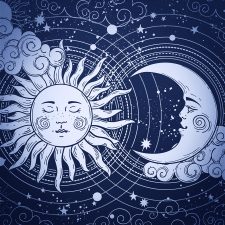
A full moon is when the Sun and the Moon are facing opposite, being in opposite direction from an Earth perspective.
This might feel astonishing if one imagines that the Moon is on one side, the Sun on the other and the Earth in between? Shouldn’t the Earth throw a shadow onto the Moon? Bingo – this is exactly what she does! But only when the Moon is exactly on the Earth orbit, the so called “ecliptic”. When this takes place, we speak of a lunar eclipse!

The Moon needs 27.33 days to circle around the Earth. Something that is also referred to as “sidereal time”. But because the Earth orbits the Sun, just like the Moon orbits the Earth, the Moon has to travel two further days in order to resume the same position to the Earth and Sun. This is then called the “sidereal time”. In order to determine the point of time of the reoccurring full moon, the sidereal time serves as basis.

We already know now that the moon month is mostly shorter than the calendar month, being on average approximately 29.5 days. If full moon falls on the first or second of a month, it is possible that another full moon occurs in the same month, for instance in July 2004:
Friday, 2 July 2004, 01:08:54 pm
Saturday, 31 July 2004, 08:05:06 pm
This event is also known as “blue moon”.
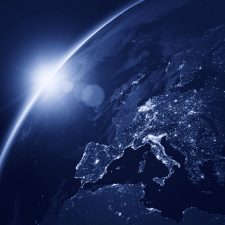
The answer is: “everywhere at the same time”. This refers to the so called Universal Time (UT) though, which is used for general astronomical events. We have already learnt that full moon is an astronomical event, where the moon, sun and the earth play a role by being in a specific position. So, full moon takes place at a specific time in the outer space. This point of time is specified by astronomers namely by the Universal Time.

There are multiple ways of approaching this question. If we look at it from a purely theoretical standpoint, we might be tempted to say that the full moon is infinitely short, since the phases of the moon are changing continuously. The moon is not yet quite full shortly before the full moon, and is already waning shortly afterwards.
However, there is a practical aspect that lets us quantify the full moon as a finite and measurable span of time: Since the Sun is significantly bigger than the Moon, its rays are able to reach just a little over half of the Moon’s surface. This means that the timespan in which the visible side of the Moon’s surface is irradiated (as seen from Earth) is longer than infinitely short.

Whether scientists, astrologers or esoterics, they agree on one thing: the moon influences earth and life on earth. For instance, it regulates the tides through its magnetism. Also continents feel the consequence of this magnetism and either raise or lower their position sometimes up to 26 cm.

In nature it is a known fact: for some animal species, mating takes place at full moon. However, the examples that can be found on this subject are rather simple. Full moon serves in some cases indirectly as the cause (for instance through the high water levels during the tides that the horseshoe crab uses to deposit its eggs) or also as the signal for both sexes of a species to begin at the exact same time to safeguard their future existence (a particular type of fly or also corals). It is understood that also wolves are led by full moon when it is time to mate.

… that people are looking for an argument at full moon or are especially happy …
… that if full moon is surrounded by a haze, a person dies …
… that you raise your hat three times to the moon (being a man) or you make a curtsey (being a woman), in order to protect yourself from misfortune until the next full moon …
… that whoever does not chink glasses with full moon at least once, does not deserve any happiness [Greek toast] …
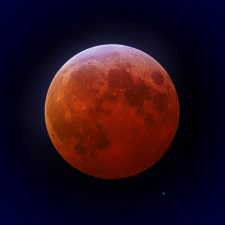
During a lunar eclipse, the Moon moves through the shadow of the Earth. Which means, that the Earth is positioned quite exactly between the Sun and Moon and casts its shadow onto the Moon. This is only possible at full moon and if some other requirements are met. Depending on whether the moon passes the partial or the core shadow of the Earth, we speak of a partial or total lunar eclipse.

More than 400 years ago, the German artist Adam Elsheimer (1578–1610) painted the picture »Flight into Egypt« (1609), where he depicted the well-known biblical scene of the escape of Joseph and Maria with the Christ Child. The special feature of this painting is, that it shows the full moon and night sky with such a richness of detail on a scale not seen before. Scientists – like for example Dr. Christian Sicka of the ›Deutsche Museum‹ Munich – have examined this work and come to the conclusion that this is possibly the first correct astronomical true to life depiction of the night sky in paintings. One can easily recognise the lunar maria on the Moon’s surface and also the Milky Way, moreover a clear graduation of brightness with the individual stars.

The Bible is undoubtedly one of the most important books in human history – most printed, most translated and worldwide the most widespread. It is the Holy Scripture of Christianity and Judaism (in different forms) and therefore the manifestation of God’s word in two of the major world religions.
The text contains, with its archaic, poetic language, many descriptions of nature and celestial events. So, it is obvious that the Sun, the Moon and the stars are mentioned. But is the full moon also to be found?
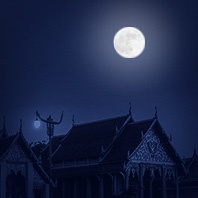
Māgha Pūjā is an important Buddhist holiday that is celebrated in Thailand, Laos, Cambodia, and Sri Lanka, on the day of the full moon, in the third month of the Thai moon calendar, in February/March. The word Māgha refers to month and Pūjā is the honoring. Legend has it that on this day 1,250 monks congregated to meet with Buddha.
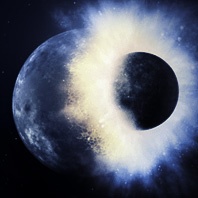
The Moon has not always been there. And although, no one has been present to observe its creation, scientists today, largely share the view that our Moon originates from a collision between Earth and another planet 4.5 billion years ago.
Our Earth – that looked completely different to how we know it to be today – had been circling with the planet Theia, which was about the size of our Mars, around the Sun. Some day, these two orbs clashed, produced an inconceivably powerful collision that totally destroyed Theia and catapulted an enormous amount of rocks into the orbit of Earth.

Fitting into the Christmas period, we are hanging up a virtual mistletoe and calling upon all lovers out there to kiss each other! The custom has a long tradition in many countries. The symbolism of fertility and vitality play as much a part as the search for the possibility of making the kiss in public socially acceptable. The mistletoe helps to overcome the inhibition, which can stand especially between two people before their first kiss. And incidentally, for every kiss one berry of the bush is plucked – until no berries are left.

Times and times again, you read about the possibility to purchase lunar property. Is this to be taken seriously or more of a gimmick or a clever sales idea? If looked at more closely, some astonishing details are coming to light …
When the manned space flight started in the 60s and a trip to the Moon became more likely, nations tried to regulate the topic such as ownership in space, and created an »Outer Space Treaty« in 1967, which prohibits states to use space or its celestial bodies for self-serving or military purposes. This treaty was signed by 98 states, amongst them the superpowers, at the time USA and Soviet Union.

When natural forces are involved, people are mostly torn between fear and fascination. They are looking for the challenge to come into contact with these forces. At the same time, everyone has to respectfully recognize these elemental forces, sooner or later. This becomes impressively apparent in surfing, when a person is gliding on a metre high wave on a surf board. If he manages to stay in front of the crest, and not to be rolled over by the breaking of the wave, he is the winner and in the belief to control the element. If he is not able to do so, it mostly turns dangerous or at least uncomfortable. It is a risky game.
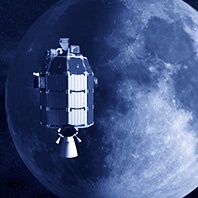
As reported back in September 2013, NASA sent the lunar probe LADEE (short for: Lunar Atmosphere and Dust Environment Explorer) into space, to circle and to explore the Moon. Especially, the formation of ice at the lunar poles has been of great interest. The space probe also collected measurement data of dust particles and gases that are close to the Moon’s surface.

Today, we would like to focus on a more culinary subject of everything that can be eaten or drunk and is prepared in connection with the full moon. Apparently, there is a multitude of vendors (especially in Switzerland), who regularly manufacture their products at the full moon and who detect that the quality of their foods differs from the foods, which have not been produced in connection with any lunar happenings. These products appear to sell accordingly and successfully. We have not been able to fathom out whether this is really related to the Moon – it might also be that the consciousness of the acting persons is different, or that the customers bring along the appropriate willingness to appreciate the reference to the full moon.

Looking at the Moon, you can recognise the spots on the surface with the naked eye, which are termed lunar maria and have always been inspiring people’s imagination. It is actually molten rock that rose to the surface during the origin of the Moon and then hardened. If looked at closer and using a telescope as an aid, you are able to make out mountains and valleys and a large amount of craters. In short: they are landscapes that give our Moon its face.